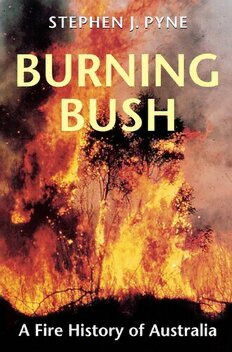Table Of ContentCYCLE OF FIRE
STEPHEN J. PYNE
"Cycle of Fire" is a suite of books that collectively narrate the story
of how fire and humanity have interacted to shape the Earth.
"Cycle" is an apt description of how fire functions in the natural world.
Yet "cycle" also bears a mythic connotation: a set of sagas
that tell the life of a culture hero. Here that role belongs to fire.
Ranging across all continents and over thousands of years,
the Cycle shows Earth to be a fire planet in which
carbon-based terrestrial life and an oxygen-rich atmosphere
have combined to make combustion both elementary and inevitable.
Equally, the Cycle reveals humans as fire creatures, alternately
dependent upon and threatened by their monopoly over combustion.
Fire's possession began humanity's great dialogue with the Earth.
"Cycle of Fire" tells, for the first time, that epic story.
World Fire: The Culture of Fire on Earth
Vestal Fire: An Environmental History, Told through Fire,
of Europe and Europe's Encounter with the World
Fire in America: A Cultural History of Wildland and Rural Fire
Burning Bush: A Fire History of Australia
The Ice: A Journey to Antarctica
"Cycle of Fire" is part of Weyerhaeuser Environmental Books,
published by the University of Washington Press
under the general editorship of William Cronon.
A complete list of Weyerhaeuser Environmental Books
appears at the end of this volume.
"Mr. Phipps and Bowman engaging the blacks who attempted
to burn us out, March 15, 1856, Depot Creek, Victoria River,"
by Thomas Raines. Courtesy Royal Geographical Society.
BURNING
BUSH
A Fire History of Australia
STEPHEN J. PYNE
With a Foreword by William Cronon
and a New Preface by the Author
University of Washington Press
Seattle &) London
Burning Bush: A Fire History of Australia by Stephen J. Pyne
has been published with the assistance of a grant
from the Weyerhaeuser Environmental Books Endowment,
established by the Weyerhaeuser Company Foundation,
members of the Weyerhaeuser family,
and Janet and Jack Creighton.
Copyright © 1991 by Stephen J. Pyne
First published by Henry Holt and Company, Inc., New York
Paperback edition published by the University of Washington Press in 1998
Foreword and Preface to the University of Washington Press
paperback edition copyright © 1998 by the University of Washington Press
All rights reserved. No part of this publication may be reproduced or trans-
mitted in any form or by any means, electronic or mechanical, including
photocopy, recording, or any information storage or retrieval system,
without permission in writing from the publisher.
Library of Congress Cataloging-in-Publication Data
ISBN 0-295-97677-2
Maps by Barbara Trapido
TO SONJA, LYDIA, MOLLY—
tolerant pynes who made worn for gums
This page intentionally left blank
Contents
Foreword by William Cronon ix
Preface to the 1998 Paperback Edition xiii
Preface to the Original Edition: Firestick History xvii
Map of Australia xxii
Map of Australia's Vegetation xxiv
Prologue: Dust to Dust 1
BOOK I: THE EUCALYPT
1. The Universal Australian 15
2. Unimaginable Freaks of Fire: Profile of a Pyrophyte 26
3. Red Centre: Fire Regimes of Old Australia 42
4. Land of Contrarities 57
BOOK II: THE ABORIGINE
5. Flaming Front 71
6. Firestick Farmer: Profile of a Pyrophile 85
7. Fires of the Dreaming 105
8. Smokes by Day, Fires by Night: Fire Regimes of Aboriginal
Australia 121
9. This Wonderful Depository of Fire 136
viii Contents
BOOK III: THE EUROPEAN
10. Entwining Fire 153
11. Reconnaissance by Fire: Education of a Pyrophile 183
12. Red Steers and Green Pick 199
13. Beyond the Black Stump 227
14. Fire Conservancy 247
15. Burning Off: Fire Provinces of European Australia 275
16. When the Billy Boiled 301
BOOK IV: THE NEW AUSTRALIAN
17. The Two Fires 321
18. Antipodean Fire: The Australian Strategy 338
19. Wild Bush, Urban Bush: Fire Regimes of New Australia 364
20. Dieback 388
Epilogue: Ashes to Ashes 410
Notes 423
Bibliographic Essay 493
Index 499
Foreword
Eucalypt History
WILLIAM CRONON
ONE OF MY REGULAR PRACTICES when teaching seminars in environmental
history is to ask students to keep a weekly journal of thoughts that occur to
them as they reflect on how our assignments and class discussions connect
to their daily lives and to what they read in the newspaper. Each week, semi-
nar members turn in their journal entries, and each week I reply with mar-
ginal commentaries that become a kind of ongoing conversation between
the students and me. One of the most remarkable such entries I ever received
arrived shortly after a series of wildfires had swept through the Berkeley Hills
in the city of Oakland, California, devastating many dozens of houses. Such
wildfires are of course a "natural" feature of the California landscape, the
inevitable consequence of people choosing to build flammable structures on
fire-prone hillsides in a climate given to frequent periods of drought.
But the journal entry my student turned in as her class assignment offered
an explanation for the recent tragedy in Oakland that was at once less obvi-
ous and more arresting. The real culprit, she argued, was Frederick Law
Olmsted. With tongue planted only halfway in cheek, she offered the
thesis—less implausible than it may first appear—that the fires could be
blamed on America's greatest landscape architect, the man who designed
Central Park and who helped promote a suburban vision in which the ideal
domestic residence was situated in a semi-urban, semi-rural landscape where
families could shelter themselves from a workaday world in cottage-like
houses surrounded by grass, gardens, and leafy trees. However attractive this
suburban vision might be as a residential environment in the eastern cities
where Olmsted first articulated it, my student said, it could hardly be less
suited to the arid West. In a place like Oakland, the greenery with which
Olmsted believed his suburban dwellers should surround themselves became

